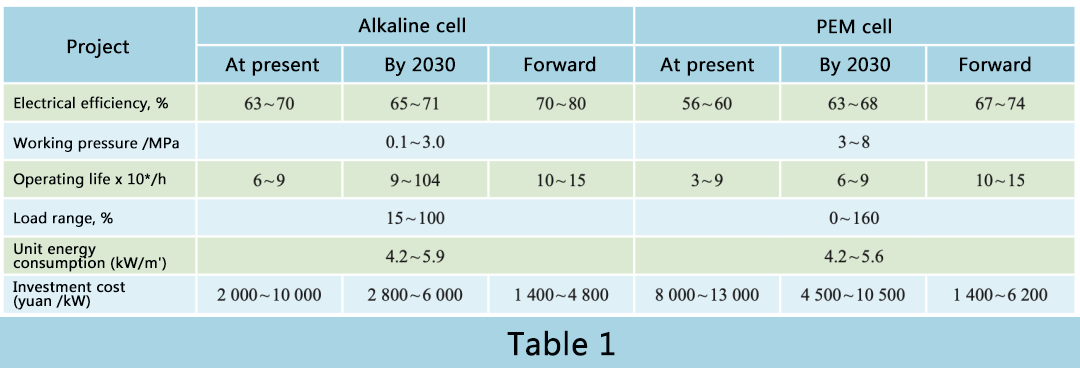More and more countries are beginning to set strategic goals for hydrogen energy, and some investments are tending to green hydrogen technology development. The EU and China are leading this development, looking for first-mover advantages in technology and infrastructure. Meanwhile, Japan, South Korea, France, Germany, the Netherlands, New Zealand and Australia have all released hydrogen energy strategies and developed pilot plans since 2017. In 2021, the EU issued a strategic requirement for hydrogen energy, proposing to increase the operating capacity of hydrogen production in electrolytic cells to 6GW by 2024 by relying on wind and solar energy, and to 40GW by 2030, the capacity of hydrogen production in the EU will be increased to 40GW by an additional 40GW outside the EU.
As with all new technologies, green hydrogen is moving from primary research and development to mainstream industrial development, resulting in lower unit costs and increased efficiency in design, construction and installation. Green hydrogen LCOH consists of three components: electrolytic cell cost, renewable electricity price and other operating costs. In general, the cost of electrolytic cell accounts for about 20% ~ 25% of green hydrogen LCOH, and the largest share of electricity (70% ~ 75%). Operating costs are relatively small, generally less than 5%.
Internationally, the price of renewable energy (mainly utility-scale solar and wind) has fallen significantly over the past 30 years, and its equalized energy cost (LCOE) is now close to that of coal-fired power ($30-50 /MWh), making renewables more cost-competitive in the future. Renewable energy costs continue to fall by 10% a year, and by around 2030 renewable energy costs will reach about $20 /MWh. Operating costs cannot be significantly reduced, but cell unit costs can be reduced and a similar learning cost curve is expected for cells as for solar or wind power.
Solar PV was developed in the 1970s and the price of solar PV LCoEs in 2010 was around $500 /MWh. Solar PV LCOE has decreased significantly since 2010 and is currently $30 to $50 /MWh. Given that electrolytic cell technology is similar to the industrial benchmark for solar photovoltaic cell production, from 2020-2030, electrolytic cell technology is likely to follow a similar trajectory as solar photovoltaic cells in terms of unit cost. At the same time, LCOE for wind has declined significantly over the past decade, but by a smaller amount (about 50 per cent offshore and 60 per cent onshore).
Our country uses renewable energy sources (such as wind power, photovoltaic, hydropower) for electrolytic water hydrogen production, when the electricity price is controlled in 0.25 yuan /kWh below, hydrogen production cost has relative economic efficiency (15.3 ~ 20.9 yuan /kg). Technical and economic indicators of alkaline electrolysis and PEM electrolysis hydrogen production are shown in Table 1.
The cost calculation method of electrolytic hydrogen production is shown in equations (1) and (2). LCOE= fixed cost/(hydrogen production quantity x life) + operating cost (1) Operating cost = hydrogen production electricity consumption x electricity price + water price + equipment maintenance cost (2) Taking alkaline electrolysis and PEM electrolysis projects (1000 Nm3/h) as an example, assume that the whole life cycle of the projects is 20 years and the operating life is 9×104h. The fixed cost of package electrolytic cell, hydrogen purification device, material fee, civil construction fee, installation service fee and other items is calculated at 0.3 yuan /kWh for electrolysis. The cost comparison is shown in Table 2.
Compared with other hydrogen production methods, if the electricity price of renewable energy is lower than 0.25 yuan /kWh, the cost of green hydrogen can be reduced to about 15 yuan /kg, which starts to have a cost advantage. In the context of carbon neutrality, with the reduction of renewable energy power generation costs, the large-scale development of hydrogen production projects, the reduction of electrolytic cell energy consumption and investment costs, and the guidance of carbon tax and other policies, the road of green hydrogen cost reduction will be gradually clear. At the same time, because hydrogen production from traditional energy sources will be mixed with many related impurities such as carbon, sulfur and chlorine, and the cost of superimposed purification and CCUS, the actual production cost may exceed 20 yuan /kg.
Post time: Feb-06-2023


